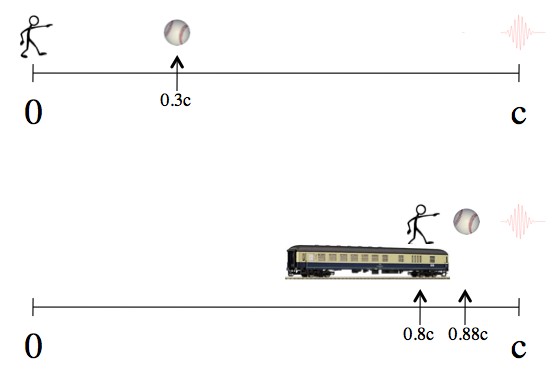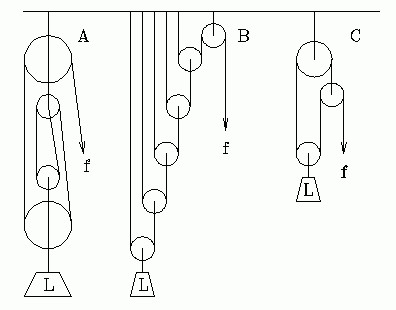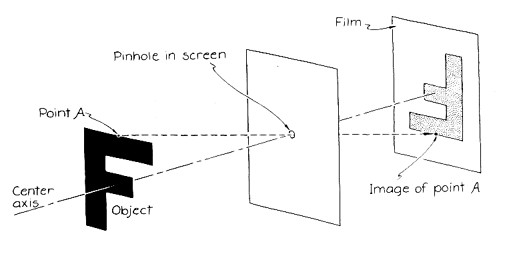Physicist: Everything in special relativity, no matter how weird, eventually boils down to the speed of light being the same to everyone. It’s just not immediately obvious how. The very short answer is: if v and w are pointing in the same direction, then their sum, V, is .
A fanatical adherence to this principle (that the speed of light is the same to everyone) allows relativistic effects to change the distance and time between events, slow the passage of (other) people’s time, even (under the right conditions) rearrange the order of events. However, what it can’t change is that an event happens, and (oddly enough) it can’t change the ordering of speeds in any particular direction.
Say you take one direction, and you have a variety of things traveling in that direction going fast, faster, and fastest. While different perspectives may disagree on exactly how fast each one is going, they will all agree on the same fast-faster-fastest ordering. And light is always the same, and always the fastest.
Imagine pitching great Walter Johnson throws a baseball at 0.3c (30% of light speed, or about 200 million mph). Clearly Walt (being stationary) is moving slower than the ball. In turn, the ball is clearly moving slower than a passing beam of light.

Top: for the pitcher's point of view he's sitting still (zero velocity), the ball is moving at 0.3c, and light is moving at c. Bottom: the same situation, but moving to the right at 0.8c. This is how you "add" 0.3c and 0.8c.
Now imagine that, unbeknownst to Walt, the entire baseball field was actually on some kind of super train tearing through the countryside at 0.8c. “Intuitively”, if the usual addition of velocities held up, the ball should be traveling at 1.1c (0.8c+0.3c). But relativity, being neither kind nor reasonable, elects instead to be stubborn about the whole “speed of light thing”.
Even on the train, Mr. Johnson is certainly still traveling to the right slower than the ball, which is still traveling slower than the light. Moving to a different frame doesn’t change the order, it just scrunches all the velocities up.
If light obeyed the normal addition of velocities, then the speed of the light beam that pitching great Walter Johnson saw should now be 1.8c as seen by someone watching from beside the train tracks (the c Walter saw, plus the 0.8c of the train moving the whole shebang), and there should be no scrunching. But it isn’t 1.8c! That’s where the fact that the speed of light is the same in all reference frames comes up.
In Walter’s frame (top) the light is (naturally) traveling at light speed, and the ball is traveling slower than that. In the frame where the whole thing is passing by on a train (bottom), the same light is still moving at c, and the ball (although traveling at a different speed) is still slower.
The classic question “what happens if I’m already on a beam of light and…” sadly doesn’t make sense from a physicsy standpoint. No material can travel that fast. In fact, nothing that experiences time can move that fast. You’re always restricted by the fact that, from your own point of view, you’re sitting still and light is traveling at light speed (try it!).
If you’d like to find out why in the example above the ball ended up traveling at 0.88c instead of something else, or what would happen if Walter “The Big Train” Johnson had thrown the ball sideways off of the train, you’ll find it milling about in the answer gravy.
By the way, here’s the same example as seen from the baseball’s point of view:

On the off chance that the question would come up, and just to emphasize the symmetry of it: this is the same example from the baseball's point of view.
Answer gravy: When you go from one frame to another (changing from moving at one speed to moving at another) all you’re really doing is rearranging coordinates. This rearrangement is called a “Lorentz boost” or a “Lorentz transformation“, and it’s surprisingly similar to a rotation (which is also just a rearrangement of coordinates). Adding velocities amounts to applying a series of Lorentz boosts.
When doing a “coordinate transform” the weapon of choice is matrix multiplication. It’s easy stuff. If you can add and multiply you can do matrix multiplication. Although I won’t lay out the technicalities here, I’ll try to be gruesomely slow algebraically.
Also, when dealing with 4-velocities (velocities that have 3 space components and one time component) it happens to be useful to not consider the time dimension, “t”, by itself, but rather “ct”. You can think of this as natural units, or whatever. It just tends to make everything work out beautifully.
A general 4-velocity looks like this: where
is the on-board time of the moving thing. This allows you to keep track of both the velocity in space (
,
, and
) as well as time (
).
An object at rest has a velocity of , that is: it’s traveling through time at one second per second (one second of your time per second of on board time).
The matrix of the Lorentz transformation to a frame moving at velocity v in the x-direction is given by: , where
and
. Gamma (as regular readers are probably sick of regularly reading) is a measure of, among other things, how much time slows down at high speeds, and is often used as a short-hand way of describing those speeds, as in “moving at a gamma of 3”. Beta (
), on the other hand, is just a more reasonable way of talking about speed. For example, when you say “half of light speed” what you’re saying is “
“.
Matrix aficionados may notice that this looks almost like a rotation in the time and x directions. Just a note, those 1’s mean that the y and z components are unaffected.
So when the pitcher throws the stationary ball he “boosts” it into a new frame (by making it move). Mathematically you can do this with matrix multiplication:
The top is time dilation.
means that for every second that passes for the baseball (
)
seconds pass for you. Also, you can get rid of the on-board time dependence and recover “normal” velocity (dx/dt, no “
‘s”) with a little algebra. Normal velocity (in the x-direction) is:
.
So, the baseball is moving with ordinary velocity v (like you’d hope) and 4-velocity . To see what happens when we boost again, by moving to a new frame where the ball’s velocity is being added to the velocity of the train, just do another matrix multiply. This time with:
It’s the same thing, just with a different speed from last time. This time
, and
.
So, what’s the normal velocity after adding the speeds v and w? What is the final velocity “V”? Algebra!:
Holy crap! The equation we normally think is right, , doesn’t work. But stir in a little special relativity and you get:
.
So, in the example from (way) above the speeds were v=0.3c and w=0.8c. So
Seems like a long trip for , but there it is. This little term keeps the speed of light in the right place, and adjusts every other velocity to stay in the right place. At low (compared to light) speeds vw is overwhelmed by c2 and
is very close to 1. In other words, when you’re not cruising about at crazy speeds you get the usual rules.
Finally, if you choose to add velocities that aren’t in the same direction, you just have to rotate one of the Lorentz matrices. For example, while all of the examples so far have been in the x direction, a boost in the y direction would be given by:
If Walter Johnson had decided to throw the ball in the y direction on the train, and everything else stayed the same, you’d figure out the end 4-velocity of the ball by doing the following boosts:
It seems a little spooky that when the velocities aren’t parallel, velocity addition is no longer commutative (notice that the alphas and betas aren’t on equal footing), and the order in which you do the boosts becomes important. Of course, it may be spooky that that isn’t always the case.

















